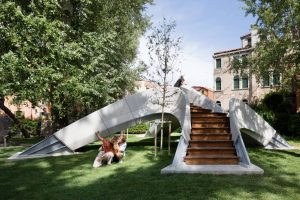
Zaha Hadid Architects and the Block Research Group at ETH Zurich have completed Striatus, the world’s first 3D-printed concrete arched bridge, in Venice, Italy.
Striatus is an arched masonry footbridge composed of 3D-printed concrete blocks assembled without mortar or reinforcement. The 16-by-12-meter (approximately 52-by-39-foot) bridge is the first of its kind, combining traditional techniques of master builders with advanced computational design, engineering, and robotic manufacturing technologies.
Striatus follows a masonry logic on two levels. Globally, the bridge behaves as a series of leaning unreinforced voussoir arches, with discretization orthogonal to the dominant force flow in compression, following the same structural principles as the arched Roman bridges in stone.
Locally, on the level of the voussoir, the 3D-printed concrete layers behave as traditional brick masonry like the inclined rows of bricks in Nubian or Mexican vaulting.
Unlike typical extrusion 3D printing in simple horizontal layers, Striatus uses a two-component (2K) concrete ink with corresponding printing head and pumping arrangement to precisely print non-uniform and non-parallel layers.
This new generation of 3D concrete printing in combination with the arched masonry design allows the resulting components to be used structurally without any reinforcement or post-tensioning. For Striatus, Holcim, a Swiss-based global building materials company, developed a specific, custom-made proprietary 3D-printing ink.
Integrating design, engineering, fabrication, and construction, Striatus redefines conventional interdisciplinary relations. The precise manufacturing of the blocks was enabled by well-defined data exchange between the various domain-specific software toolchains involved in the process.




